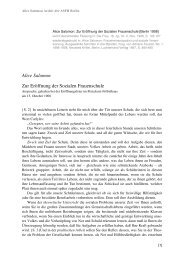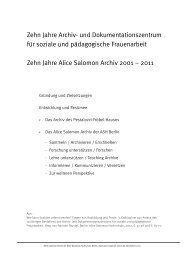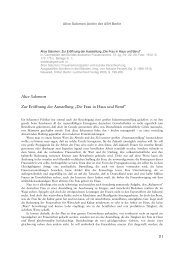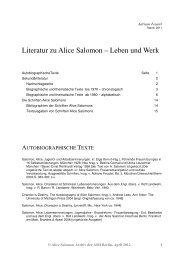Teaching Gender in Social Work - MailChimp
Teaching Gender in Social Work - MailChimp
Teaching Gender in Social Work - MailChimp
Create successful ePaper yourself
Turn your PDF publications into a flip-book with our unique Google optimized e-Paper software.
knowledge of sexual differences and the relationship between men and women.<br />
Such knowledge is not absolute but relative and it is created with<strong>in</strong> various<br />
epistemological frameworks, which vary accord<strong>in</strong>g to time and place. It refers<br />
to ideas, <strong>in</strong>stitutions, structures, everyday practices, rituals and traditions,<br />
which together create social relationships. Michelle Perrot 2 connects this with<br />
identity practices, which mould the lives of people at the present time. Due<br />
to a lack of their own history and their omission from the past, women must<br />
identify themselves with prescriptions regard<strong>in</strong>g their identity rather than with<br />
who they really are. In this sense, history is identity, as it offers much data and<br />
evidence concern<strong>in</strong>g people’s real lives, capabilities, abilities and powers. To<br />
deny the significance of women’s public actions is to deny their image reflected<br />
<strong>in</strong> their action. The consequences of this are not just that women have to look<br />
repeatedly for their own social position; they go much deeper. They imply the<br />
establishment of a false impression of time, with events be<strong>in</strong>g described as if<br />
they never happened, which establishes a hierarchy of events and actors.<br />
This all means that teach<strong>in</strong>g the female past can only be done with<strong>in</strong> an<br />
<strong>in</strong>clusive educational framework, which relates not only to women but also to<br />
all groups that society has excluded from history with a view to ma<strong>in</strong>ta<strong>in</strong><strong>in</strong>g<br />
the desired images of them. 3<br />
In the article we focus on various forms and manifestations of violence<br />
aga<strong>in</strong>st women <strong>in</strong> history. These cases have been taken from Slovenian history,<br />
but similar descriptions can be found elsewhere. 4 We shall offer some tips and<br />
case studies that can be used <strong>in</strong> classes address<strong>in</strong>g women’s bodies or violence.<br />
Women’s Bodies and Bodily Practices<br />
The social identity of women has long been conditional upon the cultural<br />
perception of their bodies. That is why the body has featured prom<strong>in</strong>ently <strong>in</strong> the<br />
fem<strong>in</strong>ist debate throughout the Second Wave of Fem<strong>in</strong>ism, whilst <strong>in</strong>dividual<br />
arguments about the body can also be found <strong>in</strong> texts written dur<strong>in</strong>g the First<br />
2<br />
Michelle Perrot, ed., Writ<strong>in</strong>g Women’s History (Oxford, Cambridge: Blackwell, 1984).<br />
3<br />
Andrea Petö and Berteke Walldijk, <strong>Teach<strong>in</strong>g</strong> with Memories: European Women’s History <strong>in</strong> International and<br />
Interdiscipl<strong>in</strong>ary Classrooms (Galway: Women’s Studies Centre, 2006).<br />
4<br />
To name just a few of them: Five volumes of the book A History of Women, edited by Georges Duby, Michelle<br />
Perrot (Cambridge: The Belknap Press, 1992). Leila J. Rupp, Worlds of Women: The Mak<strong>in</strong>g of an International<br />
Women’s Movement (Pr<strong>in</strong>ceton: Pr<strong>in</strong>ceton University Press, 1997).<br />
88














